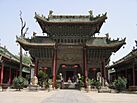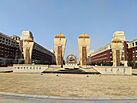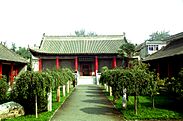Xianyang facts for kids
Quick facts for kids
Xianyang
咸阳市
|
|
|---|---|
|
Prefecture-level city
|
|
|
Maoling Mausoleum
Qianling Mausoleum
Chenghuang Temple
Iharbour Campus of Xi'an Jiaotong University
Xianyang Museum
Fenghuangtai
|
|
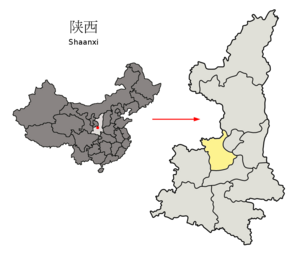
Location of Xianyang Prefecture within Shaanxi
|
|
| Country | People's Republic of China |
| Province | Shaanxi |
| Municipal seat | Qindu District |
| Area | |
| • Prefecture-level city | 10,213 km2 (3,943 sq mi) |
| • Urban | 523 km2 (202 sq mi) |
| Population
(2010)
|
|
| • Prefecture-level city | 5,096,001 |
| • Density | 498.972/km2 (1,292.33/sq mi) |
| • Urban | 945,420 |
| • Urban density | 1,807.7/km2 (4,682/sq mi) |
| • Metro | Xian |
| GDP | |
| • Prefecture-level city | CN¥ 215 billion US$ 34.6 billion |
| • Per capita | CN¥ 43,365 US$6,963 |
| Time zone | UTC+8 (China Standard) |
| ISO 3166 code | CN-SN-04 |
| Xianyang | |||||||||||
|---|---|---|---|---|---|---|---|---|---|---|---|

"Xianyang" in Simplified (top) and Traditional (bottom) Chinese characters
|
|||||||||||
| Simplified Chinese | 咸阳 | ||||||||||
| Traditional Chinese | 咸陽 | ||||||||||
| Postal | Sienyang | ||||||||||
|
|||||||||||
Xianyang (Chinese: 咸阳; pinyin: Xiányáng) is a prefecture-level city in central Shaanxi province, situated on the Wei River a few kilometers upstream (west) from the provincial capital of Xi'an. Once the capital of the Qin dynasty, it is now integrated into the Xi'an metropolitan area, one of the main urban agglomerations in northwestern China, with more than 7.17 million inhabitants. Its built-up area, consisting of 2 urban districts (Qindu and Weicheng), had 945,420 inhabitants at the 2010 census. It has a total area of 10,213 square kilometers (3,943 sq mi).
Xianyang is the seat of the Xi'an Xianyang International Airport, the main airport serving Xi'an and the largest airport in Northwest China, and one of the 40 busiest airports in the world.
Xianyang is one of the top 500 cities in the world by scientific research outputs, as tracked by the Nature Index. It is home to the main campus of Northwest A&F University (NWAFU), one of the world's top universities in agriculture science related fields, and a member of "Project 985" club which is an organization of 39 reputable universities in China.
History
Xianyang was among the capital city's environs during the Western Zhou dynasty, and was made the capital of the state of Qin in 350 BC during the Warring States period before becoming the capital of China during the short-lived Qin dynasty. Because the city lay south of the Jiuzong Mountains and north of the Wei River – both sunlight-rich (yang) orientations – it was named "Xianyang", meaning "fully yang".
Under Duke Xiao of Qin's reign, minister Shang Yang designed Xianyang and in 350 BC organized the relocation of Qin's administration from the old capital Yueyang to the new city, which was then the capital for over 140 years. It was located in the modern day Shaanxi province on the northern bank of the Wei River, on the opposite side of which Liu Bang would later build the Han dynasty capital of Chang'an once he became emperor.
In 221 BC, Qin Shi Huang eliminated all six other warring states to establish the first centralized empire in Chinese history. Xianyang became the center of politics, economy and culture of the Qin empire. Noble families were compelled to move into Xianyang, and the realm's weapons were gathered in the city to be melted and cast into twelve towering statues. The Emperor had a lavish mausoleum built near the capital, complete with his Terracotta Army. This and other large undertakings diverted enormous levels of manpower and resources away from agriculture. Coupled with the state's repressive measures on the population, these factors eventually led to the fall of the Qin dynasty and with it the original city of Xianyang.
Qin Shi Huang expanded Xianyang beyond the walls. Then he built replicas of the palaces of all the conquered states along the Wei River. In 220 BC, he built Xin Palace (Chinese: 新城; pinyin: Xīnchéng) and later renamed it Wei Palace (Chinese: 渭城; pinyin: Wèichéng), named after the Wei River. He continued with the theme of earth as the mirror of heaven building a network of 300 palaces in the Wei valley connected by elevated roads. In 212 BC, he built the Epang Palace (Chinese: 阿房宮; pinyin: Ēpánggōng).
Shortly after the First Emperor's death in 210 BC revolts erupted. At the beginning of December 207 BC, the last Qin emperor Ziying surrendered to rebel leader Liu Bang, who entered Xianyang peacefully without harming the locals. However, Liu Bang was forced to hand the city over to another more ruthless rebel leader, Xiang Yu, whose army greatly outnumbered Liu Bang's. Xiang Yu then killed Ziying and burned Xianyang in 206 BC, destroying the sole surviving copies of several banned books that were kept in the royal library.
In 202 BC, after defeating Xiang Yu in Battle of Gaixia and ending the Chu-Han contention, Liu Bang was crowned the emperor of the newly established Han dynasty, and he built a new capital across the Wei River merely miles from the ruins of old Xianyang and named this new city Chang'an. The Han-era town of Anling (Chinese: 安陵, tomb of emperor Hui) was located nearby and houses some of the Han dynasty's mausoleums.
Archeology
From the end of the 1950s until the middle of the 1990s, archeologists discovered and excavated numerous Qin era sites in Xianyang, including palaces, workshops and tombs.
Administrative divisions
| Map | |||||
|---|---|---|---|---|---|
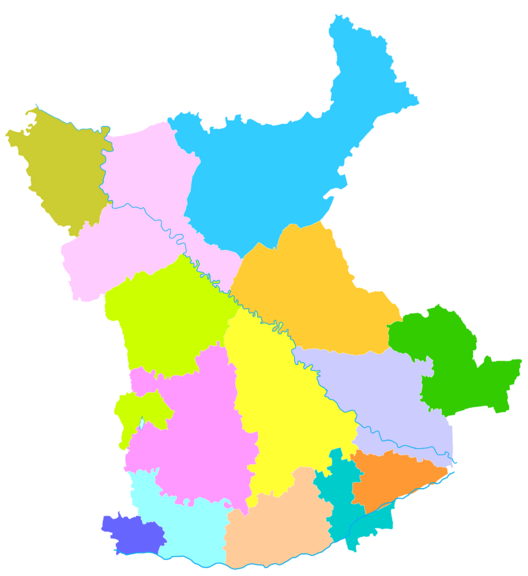
Qindu
Yangling
Weicheng
Sanyuan
County Jingyang
County Qian
County Liquan
County Yongshou
County Changwu
County Xunyi
County Chunhua
County Wugong
County Xingping
(city) Binzhou
(city) |
|||||
| Name | Hanzi | Hanyu Pinyin | Population (2004 est.) | Area (km2) | Density (/km2) |
| Weicheng District | 渭城区 | Wèichéng Qū | 400,000 | 272 | 1,471 |
| Yangling District | 杨陵区 | Yánglíng Qū | 140,000 | 94 | 1,489 |
| Qindu District | 秦都区 | Qíndū Qū | 450,000 | 251 | 1,793 |
| Xingping city | 兴平市 | Xīngpíng Shì | 560,000 | 496 | 1,129 |
| Binzhou city | 彬州市 | Bīnzhōu Shì | 330,000 | 1,202 | 275 |
| Sanyuan County | 三原县 | Sānyuán Xiàn | 400,000 | 569 | 703 |
| Jingyang County | 泾阳县 | Jīngyáng Xiàn | 500,000 | 792 | 631 |
| Qian County | 乾县 | Qián Xiàn | 560,000 | 994 | 563 |
| Liquan County | 礼泉县 | Lǐquán Xiàn | 460,000 | 1,017 | 452 |
| Yongshou County | 永寿县 | Yǒngshòu Xiàn | 190,000 | 869 | 219 |
| Changwu County | 长武县 | Chángwǔ Xiàn | 170,000 | 583 | 292 |
| Xunyi County | 旬邑县 | Xúnyì Xiàn | 270,000 | 1,697 | 159 |
| Chunhua County | 淳化县 | Chúnhuà Xiàn | 200,000 | 965 | 207 |
| Wugong County | 武功县 | Wǔgōng Xiàn | 410,000 | 392 | 1,046 |
Chinese Bureau of Statistics lists the urban population of the city at 316,641 (1990 Census), rising to 814,625 (2000 Census), and 835,648 in 2010 Census.
Climate
| Climate data for Xianyang (Qindu District, 1991–2020 normals, extremes 1981–2010) | |||||||||||||
|---|---|---|---|---|---|---|---|---|---|---|---|---|---|
| Month | Jan | Feb | Mar | Apr | May | Jun | Jul | Aug | Sep | Oct | Nov | Dec | Year |
| Record high °C (°F) | 16.0 (60.8) |
23.0 (73.4) |
30.6 (87.1) |
34.6 (94.3) |
37.8 (100.0) |
41.7 (107.1) |
39.6 (103.3) |
39.2 (102.6) |
36.8 (98.2) |
31.1 (88.0) |
24.4 (75.9) |
22.4 (72.3) |
41.7 (107.1) |
| Mean daily maximum °C (°F) | 4.7 (40.5) |
9.1 (48.4) |
15.1 (59.2) |
21.5 (70.7) |
26.4 (79.5) |
31.5 (88.7) |
32.5 (90.5) |
30.2 (86.4) |
25.1 (77.2) |
19.1 (66.4) |
12.3 (54.1) |
6.3 (43.3) |
19.5 (67.1) |
| Daily mean °C (°F) | −0.9 (30.4) |
2.6 (36.7) |
7.7 (45.9) |
14.1 (57.4) |
19.3 (66.7) |
24.5 (76.1) |
26.3 (79.3) |
24.4 (75.9) |
19.6 (67.3) |
13.3 (55.9) |
6.0 (42.8) |
0.5 (32.9) |
13.1 (55.6) |
| Mean daily minimum °C (°F) | −5.1 (22.8) |
−1.6 (29.1) |
3.4 (38.1) |
8.6 (47.5) |
13.4 (56.1) |
18.8 (65.8) |
22.1 (71.8) |
20.9 (69.6) |
15.9 (60.6) |
9.2 (48.6) |
1.9 (35.4) |
−3.7 (25.3) |
8.7 (47.6) |
| Record low °C (°F) | −16.3 (2.7) |
−12.4 (9.7) |
−8.5 (16.7) |
−2.1 (28.2) |
2.4 (36.3) |
8.7 (47.7) |
14.7 (58.5) |
12.0 (53.6) |
5.0 (41.0) |
−4.4 (24.1) |
−12.3 (9.9) |
−18.6 (−1.5) |
−18.6 (−1.5) |
| Average precipitation mm (inches) | 6.2 (0.24) |
8.8 (0.35) |
22.1 (0.87) |
34.6 (1.36) |
49.8 (1.96) |
60.5 (2.38) |
82.8 (3.26) |
84.6 (3.33) |
89.4 (3.52) |
54 (2.1) |
21.9 (0.86) |
4.5 (0.18) |
519.2 (20.41) |
| Average precipitation days (≥ 0.1 mm) | 3.5 | 3.9 | 5.9 | 7 | 8.8 | 8 | 9.7 | 9.4 | 11.4 | 9.6 | 5.7 | 2.8 | 85.7 |
| Average snowy days | 4.3 | 3.1 | 1.3 | 0.1 | 0 | 0 | 0 | 0 | 0 | 0 | 1.2 | 2.6 | 12.6 |
| Average relative humidity (%) | 64 | 63 | 62 | 66 | 65 | 61 | 69 | 75 | 78 | 78 | 74 | 66 | 68 |
| Mean monthly sunshine hours | 134.4 | 132 | 169.8 | 194.4 | 211.3 | 211 | 223.2 | 200.8 | 143.1 | 138 | 135.5 | 141 | 2,034.5 |
| Percent possible sunshine | 43 | 42 | 46 | 49 | 49 | 49 | 51 | 49 | 39 | 40 | 44 | 46 | 46 |
| Source: China Meteorological Administration | |||||||||||||
Education
Xianyang is home to the main campus of Northwest A&F University (NWAFU), one of the world's top universities in agriculture science related-fields, and a member of "Project 985" club which is an organization of 39 reputable universities in China.
National
- Northwest A&F University (NWAFU)
- Shaanxi University of Science & Technology
Public
- Shaanxi University of Chinese Medicine
- Xianyang Normal University
Transport
- China National Highway 312
- Xi'an Xianyang International Airport
- Xianyang West railway station
- Xi'an Metro Line 1




